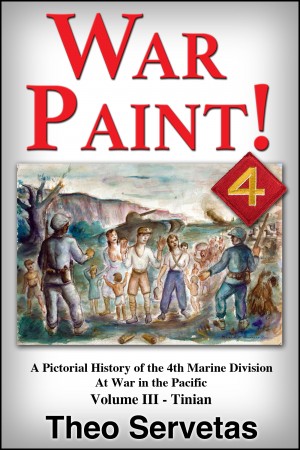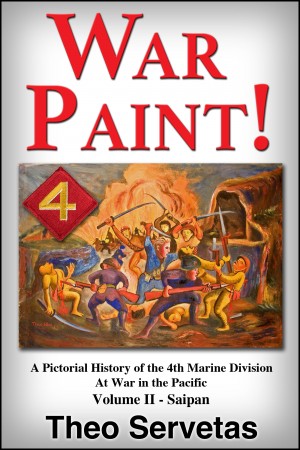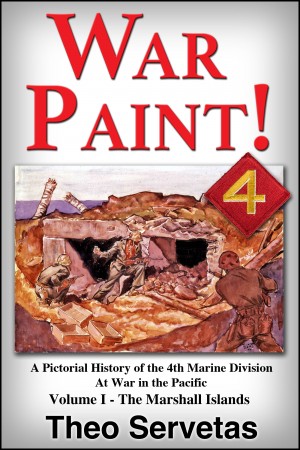Interview with Theo Servetas
Published 2015-05-30.
What do your fans mean to you?
Everything. I really do care about the materials I research and release to the public, and how that might affect someone. It is truly impossible to please everyone's sensibilities, but I really do care about the quality of my writing. It seems as though what I put in words is never good enough and find myself re-writing and editing over and over. It would please me so much to get as many reviews as possible. The feedback will be invaluable in knowing whether or not my intended message got through. That the people actually get it.
What are you working on next?
War Paint! A Pictorial History of the 4th Marine Division is a four volume series. I am very busy now getting volume one on line. That will be offered free of charge. I hope that will buy me some respect and recognition from you, the consumer, who will love my work so much that they will be not only compelled to give me a five star rating, but also buy Volumes II through IV, which I am currently preparing for release sometime during the Summer of 2015.
What is the greatest joy of writing for you?
Hearing from the people that they got it. I also have many fans visit me on my facebook page, thanking me for memorializing their relative who fought in the war. Many of those veterans that I wrote about are no longer with us.
How do you discover the ebooks you read?
Search engines and the internet. Word of mouth. Sometimes people are so knocked out by what they read or saw, they send me an email with a direct link.
What is your writing process?
Research. Draft. More research. Meet people who have first hand knowledge of the research material. Re-write and reflect upon what was written, and try to connect all the dots towards a comprehensive story. In the case of my Uncle, Theo Hios, I started out by doing a survey of his Marine Corps combat art and photography. Next, I started to look at what his contemporaries were also recording and producing. Looking at my Uncle's Marine Corps service record, and recalling what he told me several years earlier, I then discovered the Marine Corps Art Program and the efforts of the US Marine Corps Combat Correspondents Association. Fortunately, I was then able to find some survivors still around to add more insights to the story.
What is your e-reading device of choice?
Honestly, I don't have a stand alone reading device, and depend on my PC Computer to read e-books. However, I am attracted to larger screen devices that support color graphics, since my work involves a lot of images, and would hope that people who buy my book would consider a larger screen means to enjoy what I present. I have not decided upon which one to buy at the moment, but wish for at least four so I can have one each dedicated to my volumes when I present my work at a book fair or Marine Corps reunion.
What motivated you to become an indie author?
The cost to reproduce images, whether they are photographs or artworks, is astronomical. I wanted to present the reader with an objective, complete view of what the human condition was like during the war in the Pacific. Unfortunately, a traditional printing press will not take a chance to print physical books jam packed with images. Even their favorite authors are limited by the amount of images they can present. I think I am doing something new for an e-book, and hopefully, with the release of my War Paint! series, a new genre of e-book and better format will arise.
What do you think the future of e-publishing beholds?
Given the relative ease and cost to disseminate ideas and information, the potential is exponential. For better or for worse, the millennial generation is like a fish in water when it comes to digital technology. But here is another idea to ponder: What will happen to all of our e-books and articles in say, several hundred years hence? Will the mark we leave as authors and scholars stand the test of time. Is our collective data protected from natural disasters or war? Remember, some of the oldest written texts from Babylonian times survived because the information was imprinted in simple clay tablets. I am not convinced that our databases will survive eight-thousand years. How ironic it would be if some day in the future, our age is referred to as "the dark ages"!
What book marketing techniques have been most effective for you?
Word of mouth. Personal references.
What inspires you to get out of bed each day?
There is always something to do. Most things I enjoy doing. Aside from working full time, my real fulfillment is perfecting what I write. And my time is utilized to the fullest extent.
What's the story behind your latest book?
War Paint! A Pictorial History of the 4th Marine Division at War in the Pacific begins with my Uncle, Theo Hios. He was a modern artist that enlisted in the Marine Corps in 1942. During his service, he participated in the Marine Corps Art Program, a spin-off development of the Combat Correspondents Program initiated By Brigadier General Robert L. Denig. Denig relied on all Marine Corps combat artists for materials used by the Treasury Department to sell US War and Savings Bonds. Sgt. Theo Hios was also a combat photographer. I also researched many other artists and photographers from the 4th Marine Division and thus present their images from the battles for Roi-Namur, Saipan, Tinian and Iwo Jima.
What prompted you to write the War Paint! series?
Initially, I embarked on several field research trips to several archives. They included the National Archives, The National Museum of the Marine Corps, Smithsonian, and Brown University to name a few. What I was then looking for the artworks and photographs that my Uncle, Theo Hios, produced during his service with the Marine Corps in the Pacific during World War II. As a child, my Uncle told me several stories. After his passing in 1999, PBS released a documentary about combat artists, which aired sometime in 2000, called "They Drew Fire", which was complemented by a book of the same name, In it was an artwork Theo Hios did called "Ambush at Saipan". It took me several years to finally get access to the Marine Corps Art Collection. After that, the process of finding Hios' artworks and photographs came easy. I had amassed so many images, I had to take the time to arrange them on index cards to put it all in perspective.
Originally, I intended to write a stand alone book about the modern artist, Theo Hios, featuring his war years. But something was missing, It did not feel genuine, as if I was making the claim to the world that my Uncle was the only combat photographer and the only combat artist. He was not. Soon I discovered many others in the ranks who were as talented and produced their own body of work. More trips to the National Museum of the Marine Corps and NARA were in order.
Here is how my first draft of "War Paint !" Was born: In March of 2010, N.Y. Daily News Sports Editor, Bill Gallo, started writing a series of article that featured HBO's series "The Pacific". I recall reading the first review by Gallo, who wrote, that he was in the 4th Marine Division, H&S Company, 20th Marines (Engineer) Battalion. Holy cow! I thought, this is the same outfit as my Uncle, Sgt. Theo Hios - so I sent Bill Gallo an email. Within twelve hours, Bill Gallo sent me a reply asking me to call him at his office. Subsequently, I took the train to Manhattan and had one of many visits with this very productive 88 year old Sports Editor at the N.Y. Daily News. He also referred me to several other artists, such as Stan Lacey and Joe Bruni.
And about the same time I made contact with John Stone at the 4th Marine Division association, who referred me to another 4th Division Veteran, John Link, who knew my Uncles commanding officer and had a lot of images taken by my Uncle as well.
And thus, at that point in time the ice of writers block finally melted. I spent the next 9 weeks writing ten chapters of my first draft of "War Paint !" The HBO series "The Pacific" aired one time a week on Sunday. I worked on one chapter during my spare time, usually in the early morning hours before or after work, and establish a press deadline - right before "The Pacific" aired, and sent a copy of the chapter draft to my imaginary editor, Bill Gallo, via email.
That was the best writing experience I ever had. Bill Gallo turned out his own reviews of "The Pacific" series, and began to reflect on his own genuine experiences, which I feel were stimulated with what I was writing from the point of view of my Uncle's experiences that I presented in my chapters.
I was also lucky to spend so much quality time talking to John Link and Joe Bruni. All told, their inputs brought my work to life. Prior to that it was just photographs and artwork that I found in the archives.
Yes, it was a great experience and journey in life. Along the way I met so many nice people.
Where did you grow up, and how did this influence your writing?
Most of my formative years I grew up in Manhattan, New York City. Now you would think growing up in a big metropolis one would be inherently cosmopolitan, and all that. But growing up in a middle class neighborhood is in many ways like living in a small town. There was no internet back in those days, and the local library was a place for the retired to spend time reading the newspaper, as the stacks were not up-to-date. I worked the City College Library and was exposed to thousands of books, which forced me to speed read. I learned how to type at the library, processing Inter Library Loans for the pre-med students. That process involved the use of a IBM punch card, so you had to be letter perfect, or, start a new card all over again. It was not until my graduate school years when I really started to research and write on a serious level. My research was done in obscure places like the U.S. Department of Commerce in Guangzhou, China towards a lengthy Master's Thesis I wrote about China's Special Economic Zones.
Are you concerned that someone might print your book and try to sell it?
Absolutely not! Although this statement is not a guarantee that you will be able to print on demand, if you can find a means and want to take the time and expense to print all four volumes, then go for it! I will even autograph it for you if we should ever have the opportunity to do so. But in reality, the cost to reproduce my volumes on paper will be so cost prohibitive, I doubt anyone will find a market to re-coup their expenses. Just remember, if you want to use my material formally in your publication, you must secure the necessary permissions, and quote the source accordingly.
Describe your desk
A mess.
Smashwords Interviews are created by the profiled author or publisher.




